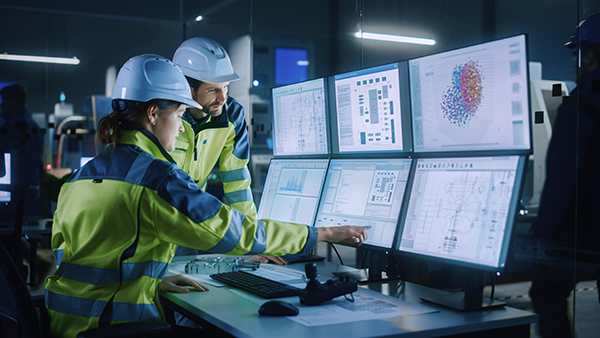Discover how AI tools are revolutionizing cybersecurity in manufacturing, enhancing protection and resilience in the age of Industry 4.0.
By Leo Vieira and Orion Czarnecki, Stefanini Group
Cybersecurity threats in the manufacturing space have been more common and significant—exposing organizations to costly issues such as disruption in the production process. As the sector transitions into the era of Industry 4.0, the need (and pressure) for manufacturing to adopt advanced cybersecurity measures and implement proactive strategies has never been greater. The shift is important not only for protecting infrastructure and sensitive data but also for minimizing vulnerabilities. While the sector has been slower to adopt technology than other industries, using AI tools to enhance cybersecurity efforts can make an organization feel empowered and respond more effectively to emerging risks.
Historically, manufacturing plants operated in isolated networks, largely insulated from external access and potential breaches. With the advent of cloud-based tools, IoT, and smart manufacturing initiatives, these environments have transitioned to more open and more interconnected systems that leverage data for both enhanced efficiency and productivity. However, as manufacturers shift to connected frameworks, they open the door for cybersecurity threats.
Manufacturers are also relying on AI-powered technologies to address these types of vulnerabilities. AI offers the ability to detect patterns, predict threats, and even monitor systems continuously. For manufacturers, the implementation of AI could mark the difference between a resilient operation and one exposed to critical cyber risks.

Manufacturing faces a unique set of cybersecurity challenges from a vulnerability perspective. Unlike sectors such as healthcare or finance, which have long been tech-driven, manufacturing is only now adapting to broader digitalization through innovations like the Internet of Things, automation, and data-driven systems. So, since they are in the early stages of building comprehensive strategies to manage cyber threats effectively, it leaves them more vulnerable as they often have outdated legacy systems with limited security measures, which makes them more exposed to potential attacks.
These outdated systems were not originally designed to be connected to modern networks, which can lead to defense gaps that hackers can potentially exploit. And the fact that production facilities process continuously can make it even more challenging to implement security updates without risking downtime.
Another significant obstacle is asset management, a critical element in securing manufacturing systems. Many plants still lack a complete inventory of their assets, making it difficult to categorize, secure, and monitor each component. Without an understanding of what assets exist and how they interconnect, it’s nearly impossible to protect against potential breaches effectively and AI can play a vital role in identifying and managing these assets.
To create a secure manufacturing environment, there are three main pillars: discovery and organization, vulnerability assessment, and strategic reporting.
Manufacturers must first understand their existing assets and the relationships between them. AI tools can be used to help discover, categorize, and organize each device within the network. Using AI in this way allows manufacturers to gain a comprehensive view of their environment. By automating this initial step, manufacturers can free up their cybersecurity teams to focus on high-impact work rather than inventory management.
Continuous assessment of vulnerabilities is also important in order to maintain security as technology evolves. AI helps identify and evaluate potential weaknesses, even in the most challenging cases, such as systems with specialized software that require specific patches. These systems, which tend to account for around 10% of necessary updates, are the hardest to achieve, but an experienced technology partner can help manufacturers reach these high compliance thresholds. The most challenging vulnerabilities often arise in specialized software configurations that require targeted approaches, but with AI-driven assessments, manufacturers can significantly enhance their security posture.
Effective reporting is also important to demonstrate compliance with cybersecurity standards. You have to have somebody dedicated to that. As new regulations such as CIRCIA enforce stricter accountability measures, manufacturers face heavy penalties for non-compliance. AI streamlines reporting by generating insights into areas of risk and progress, enabling manufacturers to proactively address security gaps and avoid penalties.
The integration of AI tools in manufacturing cybersecurity is accelerating and will help organizations safeguard critical infrastructure. AI helps recognize patterns in data flow, predict unusual access, and summarize out-of-the-ordinary activities, and, in cybersecurity, it can help discover, monitor, and report vulnerabilities, freeing up human resources for strategic tasks. Overall, AI integration allows manufacturers to stay ahead of risks — not only protecting their operations, but building resilience, confidence and trust with their customers and the industry at large.

About the Authors:
Leo Vieira, digital industry director with Stefanini Group, is a results-oriented business leader renowned for his deep expertise in digital transformation and IT innovation. With a career spanning over two decades in the technology sector, Leo specializes in strategies that drive growth and operational efficiency. His strong background in project management and consulting allows him to bridge the gap between technology solutions and business objectives seamlessly. At Stefanini, Leo leads teams in implementing advanced digital solutions that enhance client productivity and streamline workflows.

Orion Czarnecki, head of cybersecurity at Stefanini Group, is a forward-thinking strategist dedicated to crafting digital solutions that foster business agility and modernization. He brings over a decade of experience in data analytics, cloud computing, and AI-driven strategies, consistently aligning technology initiatives with client objectives. Known for his analytical approach to problem-solving, Orion plays a key role at Stefanini by guiding teams toward impactful digital transformations, ensuring clients remain competitive and innovative within their industries.
In this episode, I sat down with Beejan Giga, Director | Partner and Caleb Emerson, Senior Results Manager at Carpedia International. We discussed the insights behind their recent Industry Today article, “Thinking Three Moves Ahead” and together we explored how manufacturers can plan more strategically, align with their suppliers, and build the operational discipline needed to support intentional, sustainable growth. It was a conversation packed with practical perspectives on navigating a fast-changing industry landscape.